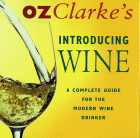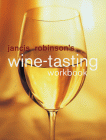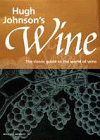
Back to the bookshop front page...
|
Oz Clarke Hardcover - 144 pages (14 September, 2000)
Reviews Amazon.co.uk You've seen him doing it on telly, all that swirling and sniffing and slurping and spitting, you've flicked through a few of his books, but you really aren't that interested in wine. The idea doesn't do much for you. But Oz Clarke won't give up. He still has designs on you and your palate. The latest manoeuvre in his campaign to educate the world's taste-buds is Oz Clarke's Introducing Wine, an ungainly title for an elegant little book. Subtitled "A Complete Guide for the Modern Drinker", it offers a simple, but not simplistic, entry into the pleasures of wine. Oz Clarke takes something of a Year Zero approach to wine: forget the mystique, the reputations, the inflated prices, the snobbery--all that matters is the quality. Consequently he approaches all wines in the same spirit, asking the same questions in a kind of catechism. Part I covers briefly but incisively the major grape varieties, an essential starting point in this wine world view, grouping them in flavour categories such as Spicy, Warm-hearted Reds or Green, Tangy Whites. Amusingly, and effectively, the special flavours of each class are illustrated rather than described at length, the Green, Tangy Whites being accompanied by a skewer of gooseberry, apple, mint, lime, asparagus and green pepper. Part II deals effectively with the practicalities of enjoying wine--opening the bottle, serving wine etc. Part III is the meat of the book, dealing with the major wine-producing countries, divided into regions as appropriate. For each, he provides a Quick Guide, describing location, principal grape varieties, top vintages and label recommendations; then asks his standard set of questions: Do regions matter? Do vintages matter? When do I drink them? and Can I afford them? As ever with Oz Clarke, the answers are honest, reliable, utterly without prejudice and invigoratingly written. --Robin Davidson Book Description Here, at last, from Oz Clarke, the UK's most popular wine writer, comes the ultimate no-nonsense guide to wine. No jargon. No frills. No previous knowledge assumed. Just how to enjoy the kind of wine that is actually in the shops at the moment. Oz Clarke's Introducing Wine features: Grapes - Find the key to every taste and style Regions - Use the Quick Guides for essential know-how Actual recommendations - Avoid expensive mistakes from the start Wine terms - Understand the terms you need to know Food and wine matching - Get it right every time Practical details - Select, buy, serve and taste wine with confidence In this volume, wine jargon is explained in simple terms, expert tips give you the inside track, and wine snobbery and wine myths are put firmly in their place. Straightforward explanations detail what wine is, how it is made and why both flavour and quality vary so much from one wine to the next. A guide to the most important grapes (Cabernet Sauvignon, Chardonnay) describes their characteristic tastes and styles and the sorts of foods they go well with. All the key elements of enjoying wine are included: how to taste, buy, store and serve wine, how to choose wine in a restaurant and how to match wine and food. A virtual tour of the shelves of a wine shop gives essential information on the wines of each country and region: the flavours, the styles, the quality and affordability. The guide is aimed at those who want to know about wine and how to make the right choices, without being overwhelmed with information. Synopsis From the Author I begin by grouping wines into 'flavour families' - they're all based on flavours you'll know and recognise and you will have a pretty good idea if they sound enticing to you or not - do 'juicy fruity reds' or 'intense nutty whites' sound good to you? They do to me! - and this section is your starting point for finding wines you really want to drink. Then, paring away technical details, I introduce you to the all important subject of grape varieties (grapes are what wine's made of after all - and the majority of modern wine is labelled by grape variety these days), then a bit of non-technical stuff about winemaking techniques, and then the practical business of serving and storing wine - and all in as straightforward a way as I know how, by linking everything to how it affects the flavour of the wine in your glass. Most wine books look at the wine-producing regions of the world, and I haven't entirely broken with that tradition, but I've taken a new approach. Yes, I tell you where the wines whose names you see on bottles come from - and it's fun and instructive to know that - but more importantly I try to answer the questions I'm most frequently asked. Do vintages matter? Well, sometimes they do, sometimes they don't, but either way I'll tell you why. Can I afford it? Even if the wines of a particular region are expensive or overpriced, I'll suggest some good-value options that will give you a taste of what it's all about. All in all through the book, I've recommended 300 wines for you to try. Start with the ones you like the sound of and introduce yourself to the exciting modern world of wine. Cheers. Buy this book from amazon.co.uk
BBC Consumer Publishing (Books); ISBN: 0563551313 Reviews wineanorak.com Intended as a companion to the BBC TV series, this book actually has little in common with the programmes, which were Jancis' imaginitive and personal snapshots of the different grape varieties, each episode focusing on a different grape by looking at the region that achieves the best with that variety. Instead, the book is a comprehensive introductory wine course that gives the wine novice a thorough grounding in the basics. If this all sounds a little dry, it isn't—Jancis in print is much as she is on telly; witty, sophisticated and eloquent. However, to anyone who has read around the subject of wine a bit, the book covers a lot of familiar ground. An ideal starting point in your reading about wine. Book Information Designed to ensure that you get the most out of every glass, Jancis Robinson's Wine Course covers everything from how to taste and store wine, to deciding what to serve on special occasions, and the best-value bottles to order in restaurants. With an updated vintage guide including the best regions in 1998, choosing your wine has never been more interesting and enjoyable. "She has an encylclopedic grasp of her subject and doesn't put a foot wrong ... a splendid introduction to the world of wine..." -- Stephen Brook, Decanter Magazine Buy this book from amazon.co.uk
Jancis Robinson Hardcover - 208 pages (19 October, 2000)Conran Octopus; ISBN: 1840911395
Reviews I usually find 'introduction to wine' books yawn-inducingly dull, but this is different. Jancis strikes the balance right between imparting essential information and keeping the book lively and fun, without falling into the trap of dumbing down or forced jokiness. There's all the usual material that these sort of books usually have, but with a fresh twist. Best of all, this book is intensely practical in its nature: the focus is on actually drinking the stuff (an indication of this is given by the title of the foreword: 'A book for the thirsty'). I can't help feeling that this is healthy and appropriate for a book about wine. One of the most effective features is that Jancis has divided the text is divided into sections on both theory and practice, and it’s the latter components that set this book apart from the competition. While any old hack can write about wine theory, it is a whole lot more difficult to write successfully and sensibly about the practical side of wine tasting, and this is done here very well. A further useful feature is the glossary of wine tasting words, which are sensibly and accessibly described. Although this is clearly targeted at the novice wine geek -- for whom I'd say this was pretty much compulsory reading -- I think it has a lot to offer the more serious wine nut. I found it a really good read, and for me it helped provide a nice balancing perspective. Let's face it, there's an awful lot written about wine, but not a great deal about how it actually tastes, and this is surely what counts. Wine is a complex subject -- and to someone new to wine this complexity can seem bewildering. So if you are starting out on the road to wine geekdom, I can think of no better book to guide you on your way.
Hugh Johnson Hardcover - 254 pages (28 October, 1974)
Buy this book from amazon.co.uk
|
 Introducing Wine
Introducing Wine Jancis Robinson's Wine
Course
Jancis Robinson's Wine
Course
 Wine
Wine